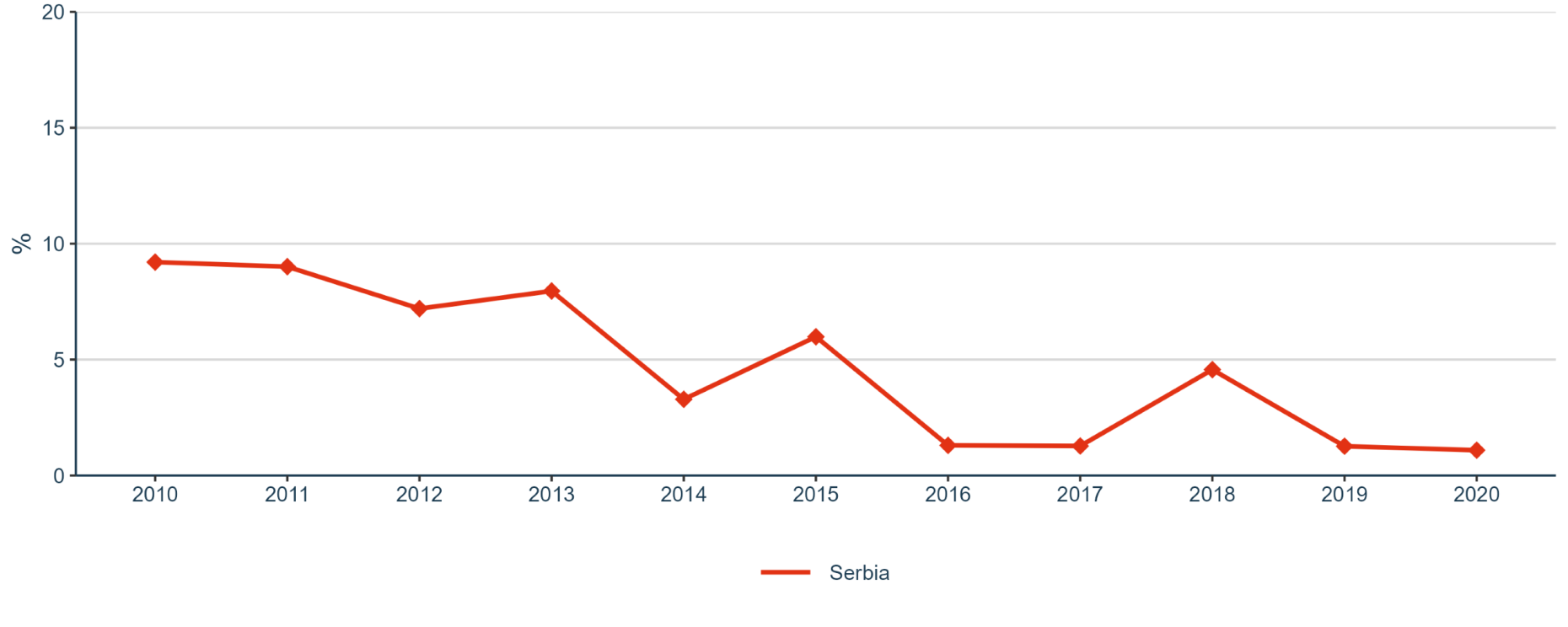ERA Country Report 2023
Serbia
Edited by Domagoj Racic (Independent Science, Technology and Innovation policy expert)
as part of ‘Development of the ERA Scoreboard, the ERA Dashboard and the Regular Reports’ project for the European Commission, Directorate-General for Research and Innovation under Framework Contract N° 2018/RTD/A2/OP/PP-07001-2018 Lot 2 (EDAR)
Click here to download this country report![]()
- Table of contents
-
ERA Country Report 2023: Serbia
1. National context
1.1. Overview of the ERA policy agenda implementation
1.2. Policy context
2. Assessment of the Implementation of the ERA Policy Agenda and ERA Priorities
2.1. ERA Priority 1: Deepening a truly functional internal market for knowledge
2.2. ERA Priority 2: Taking up together the challenges posed by the twin green and digital transition and increasing society’s participation in the ERA
2.3. ERA Priority 3: Amplifying access to research and innovation excellence across the Union
2.4. ERA Priority 4: Advancing concerted research and innovation investments and reforms
3. Country-specific drivers and barriers
4. Final remarks
5. Bibliography
6. Annexes
6.1. Annex 1: Graphs
ERA Country Report 2023: Serbia
|
Key takeaways:
|
1. National context
1.1. Overview of the ERA policy agenda implementation
According to the European Innovation Scoreboard 2023, Serbia is an Emerging Innovator with performance at 63.2% of the EU average. Its performance is improving at a rate higher than that of the EU (8.5 percentage points) and is above the average of the Emerging Innovators. The country’s performance gap compared to the EU is becoming smaller.
Serbia has not yet committed to any ERA actions, but its R&I policy has been moving towards ERA priorities. The main strategy for the R&I environment in Serbia is the Smart Specialisation Strategy (S3) of the Republic of Serbia for the period 2020 to 2027. Its framework is directly rooted in Serbia's participation in the ERA. S3 implementation has been operationalised through the new Action Plan for 2023-2025, adopted on 28 December 2023 (see also section 1.2.). Additionally, the Strategy for Scientific and Technological Development of the Republic of Serbia for the period from 2021-2025, "Power of Knowledge" represents the national roadmap for integration into the ERA - the ERA Roadmap.
1.2. Policy context
Serbia has recently introduced significant changes in the R&I policy governance. Following the appointment of a new government in October 2022, the former Ministry of Education, Science and Technological Development went through restructuring into the Ministry of Education and the Ministry of Science, Technological Development and Innovation (NITRA). Consequently, NITRA has been responsible for the development of research and innovation system and policies in the country.
Research and innovation activities are financed on a project basis through two state funds: the Science Fund and the Innovation Activity Fund. NITRA coordinates research sector reforms under the Serbia Accelerating Innovation and Growth Entrepreneurship (SAIGE) project, implemented from 2019 to 2024. Its objectives are to improve the relevance and excellence of scientific research and to improve innovative entrepreneurship and access to finance for innovative enterprises with a high growth potential.
The total value of SAIGE is EUR 84.5 million, which the EU finances through the Instrument for Pre-accession Assistance - IPA 2019 (EUR 41.5 million) and a World Bank loan (EUR 43 million). Project components include (1) Reform of the research sector and provision of financial and other support through the Science Fund for science-industry linkages, cooperation with the EU and with the Serbian research diaspora, as well as for institutional transformation, skills development and capacity building; (2) Provision of support to innovative businesses through the Innovation Activity Fund, which includes an acceleration programme, a business angel programme, technical assistance and mentorship and (3) Coordination, monitoring and capacity building. Another key project recently launched is the construction of the BIO4 biotechnology campus with EUR 450 million of funds allocated, which will make Serbia one of the most advanced European centres for biotechnology.
In 2020, the Smart Specialisation Strategy of the Republic of Serbia for the Period 2020 to 2027 was adopted; its implementation was further elaborated in the Action Plan for 2021-2022. In September 2023, the new Action Plan for 2023-2025 was subjected to public consultation, and its adoption was completed in December 2023. Other key R&I strategies are the Strategy of Science and Technology Development for the period 2021-2025, “The Power of Knowledge”, and the Strategy for Development of Start-up Ecosystem 2021-202511. The latter strategy aims to speed up the development of the start-up ecosystem by raising start-up entrepreneurial capacity through educational programmes, improving infrastructure, programme support, financing and business environment for start-ups and promoting start-up culture and global recognition of the ecosystem.
The 2019 Law on Science and Research defined the elements of the science and research system, including research careers, institutional and other funding, quality assurance, organisation of research institutes etc. A new Law on Innovation Activity was adopted in December 2021, defining the elements of the national innovation system and expanding the Innovation Activity Fund mandate to invest in companies, alternative investment funds and other organisations to develop innovations.
According to the European Commission, Serbia is at a good level of preparation in science and research, but the national level of investment in research remains low. Although there are no explicit commitments to the ERA Policy Agenda, the Commission staff working document acknowledges that the main priorities of the European Research Area have been incorporated in the Strategy for Development of Start-up Ecosystem 2021-2025. The European Commission emphasised that future policy interventions should increase the national funding for research and innovation, enact the European Research Infrastructure Consortium (ERIC) Regulation into national law and follow up on the actions of the new European Research Area.
2. Assessment of the Implementation of the ERA Policy Agenda and ERA Priorities
Although Serbia has not committed to any ERA actions, several activities contribute to achieving the ERA and its priorities. This section focuses on the progress observed, as measured by the indicators in each ERA Priority Area. The figures mentioned in the text and related to specific indicators can be found in Annex 1.
The quantitative information presents the most recent data available for the ERA Scoreboard and Dashboard indicators. However, in some cases, the data available pre-dates the ERA Policy Agenda. Therefore, the longer-term trends covering the last ten years are presented. The indicators falling under each ERA priority are presented below, and the general indicators are outlined in Table 1. More detailed information on the data and graphs can be found in Annex 1. This report will serve as a baseline for reporting in the future.
|
Indicator |
Most recent EU average |
Most Recent Metric |
|
Gross Domestic Expenditure on R&D (GERD) as a percentage of GDP |
2.26 (2021) |
0.99 (2021) |
|
Government Budget Allocations for R&D (GBARD) as a share of GDP |
0.76 (2021) |
0.43 (2021) |
|
Researchers (in full-time equivalent) per million inhabitants |
4,483.4 (2021) |
789.4 (2021) |
|
Business Enterprise expenditure on R&D (BERD) as a percentage of GDP |
1.49 (2021) |
0.4 (2021) |
Source: compiled by research team based on the ERA Scoreboard and ERA Dashboard indicators
2.1. ERA Priority 1: Deepening a truly functional internal market for knowledge
2.1.1.State of play in the implementation of the ERA Actions
Several policy documents have demonstrated commitment to implementing the principles of Open Science in Serbia and ERA Action 1: Enable Open Science, including through the European Open Science Cloud (EOSC). The country adopted the Open Science Platform in 2018 and actively participated in the European Open Science Cloud (EOSC). Serbia's support towards open science is also evidenced by its engagement in European projects and initiatives, notably Pasteur4OA and OpenAIRE. These recent developments have resulted in a rapid growth of institutional repositories. As of 2023, approximately 80 institutions had established repositories, a significant increase from the fewer than 10 that existed before July 2018. Additionally, Serbia counts on two national portals National Open Data Portal and National Open Science Portal.
According to Serbia’s response to the EOSC survey, national EOSC-relevant policies and the appointment of a Mandated Organisation to the EOSC Association are in planning, and the provision of making FAIR data searchable with the EOSC and the FAIRisation of data are considered in Serbia’s funding.
In relation to ERA Action 3: Reform the Assessment System for research, researchers and institutions and ERA Action 4: Promote attractive research careers, talent circulation and mobility, most larger universities have endorsed the European Charter for Researchers and the Code of Conduct for the Recruitment of Researchers. Additionally, the online portal “Study in Serbia” is the designated platform for international students seeking higher education opportunities in Serbia. It offers comprehensive details on universities, study programs, admission processes, and other pertinent information for those considering studying in Serbia. Additionally, the national EURAXESS portal provides resources and assistance for researchers in Serbia, including information on job opportunities, funding, and research collaboration.
Moreover, NITRA allocates funds to support 17 programme activities to foster the growth and advancement of individuals involved in scientific research. These initiatives are outlined in five distinct four-year programmes, and an annual public announcement is made inviting proposals for their implementation.
Towards the implementation of ERA Action 5: Promote gender equality and foster inclusiveness, Serbia adopted a new Law on Gender Equality in May 2021, serving as the comprehensive law for safeguarding women's rights. During the same year, the Law on Prohibition of Discrimination was amended and new strategies were introduced, including the Strategy for Preventing and Combating Gender-Based Violence and Domestic Violence for 2021-2025, along with a revamped national Strategy for Gender Equality. Serbia was the first non-EU country to launch a Gender Equality Index in 2016. Despite these advancements, there is still room for improvement, especially improve access to top-positions and management and supervisory bodies, as well as in the integration of the gender dimension into the contents of the research.
In relation to ERA Action 7: Upgrade EU guidance for a better knowledge valorisation, the Innovation Fund of the Republic of Serbia (IF) actively supports knowledge valorisation. The fund aims to enhance the connections between science, technology and economy. The fund implements the Technology Transfer Program (TT Program), which supports R&D institutions to increase their ability and efficiency in the commercialisation of inventions. Moreover, the SAIGE project promotes knowledge valorisation across the country.
Serbia contributed to the implementation of ERA Action 8: Strengthen research infrastructures by adopting a national Roadmap for Research Infrastructures in 2018. Last December, the government announced the development of a new bioeconomy hub, BIO4 campus, which is expected to be completed by the end of 2026. It will make Serbia one of the most advanced European centres for biotechnology.
ERA Action 9: Promote international cooperation is mainly implemented through bilateral and multilateral projects and initiatives. NITRA actively cooperate with 14 countries through bilateral scientific programs, encompassing both EU and non-EU countries. Since 2010, more than 1,300 bilateral projects have been funded through publicly announced calls. Serbia currently participates in 9 multilateral cooperation programs, including Horizon Europe, Eureka, COST, European Organization for Nuclear Research, United Institute for Nuclear Research, Fulbright academic exchange program, SAF€RA initiative, cooperation programs in the Danube region and Program for financing multilateral scientific and technological cooperation in the Danube region – BMBF.
Currently, Serbia is actively engaged in executing two macro-regional strategies: the EU Strategy for the Danube Region (EUSDR) and the EU Strategy for the Adriatic-Ionian Region (EUSAIR). Furthermore, Serbia is involved in delivering the EU's Western Balkans Agenda focusing on Innovation, Research, Education, Culture, Youth, and Sport.
2.1.2. Progress towards achieving ERA Priorities
The progress against Sub-priority 1.1: Open science, is measured by the share of open access scientific publications in total scientific publications. In 2019, the value for Serbia was 42.10% (Figure 5 in Annex 1).
As for Sub-priority 1.2: Research infrastructures, Serbia participates in 3 European research infrastructures.
When it comes to Sub-priority 1.3: Gender equality, equal opportunities for all and inclusiveness, Serbia usually performs very well. As can be observed in Figure 6 in Annex 1, the proportion of females among doctoral graduates by narrow fields of STEM in Serbia is stable (48% in 2020). The proportion of papers with mixed gender authorship in the last decade has been consistent; in 2020, it reached 69.5% (Figure 7 in Annex 1). Until 2018, when the data series ends, the proportion of females in authorships of the 10% most cited publications in Serbia was noticeably high, 41.1% in 2018. There is no data on the Women in Digital Index in 2022 (Figure 8 in Annex 1). The percentage of female researchers in Serbia grew in the last years and reached 52.3% in 2021.
In Sub-priority 1.4: Careers and mobility of researchers and research assessment and reward systems, the number of new doctorate graduates (25-34) per 1,000 inhabitants decreased from 0.6 in 2015 to 0.4 in 2021 (Figure 10 in Annex 1). The share of foreign doctorate students as a percentage of all doctorate students has been just over 7% (7.3 in 2020) since 2017 (Figure 9 in Annex 1). Job-to-job mobility of human resources in science & technology in Serbia exceeded 5% in 2017 and has slightly increased since, reaching 5.7% in 2020 (Figure 11 in Annex 1).
The progress in Sub-priority 1.5: Knowledge valorisation, is measured by the share of innovating firms collaborating with HEIs/PROs out of all innovative firms. This indicator has been growing in Serbia since 2012 and has been consistently high (almost 17%) since 2016 (Figure 12 in Annex 1). A best practice example from Serbia in knowledge valorisation has also been identified in the European Commission’s Repository of Best Practices: the Nova Iskra Creative Hub from Belgrade, established in 2012, targets students, start-ups, SMEs, hubs, creative industry professionals and the civil sector. It offers space, mentoring programs, webinars, courses, study programmes, creative camps, workshops and peer-to-peer exchanges.
In Sub-priority 1.6: Scientific leadership, Figure 13 in Annex 1 shows that Serbia’s share of scientific publications among the top-10% most cited publications worldwide in all publications has increased from 3.9 in 2017 to 5.3 in 2020 (9.8 in 2020). Moreover, the Academic Freedom Index is relatively high, but it has been decreasing in the last few years (Figure 14 in Annex 1). The total number of published papers is increasing, but it has been reducing, and the number of citations is relatively low.
Sub-priority 1.7: Global engagement is tackled by the number of international co-publications with non-EU partners per 1,000 researchers (Figure 15 in Annex 1), which has been growing consistently in Serbia, reaching 697 in 2022.
2.2. ERA Priority 2: Taking up together the challenges posed by the twin green and digital transition and increasing society’s participation in the ERA
2.2.1. State of play in the implementation of the ERA Actions
In relation to ERA Action 11: An ERA for green transformation and ERA Action 12: Accelerate the green/digital transition of Europe’s key industrial ecosystems, the Smart Specialisation Strategy defines Energy-Efficient and Eco-Smart Solutions as a horizontal priority. Additionally, the Ministry of Science, Technological Development and Innovation has developed the Green Program of Cooperation between Science and Industry. The programme aims to achieve sustainable development and enhance environmental quality by addressing issues mitigating climate change, environmental pollution, biodiversity loss and unsustainable use of natural resources.
Serbia has made great efforts to digitalise public administration. In 2017, the Office for Information Technology (IT) and e-Government was established, with the responsibility of advancing e-government and online information systems. Further, the State Data Centre in Kragujevac has recently been established, which will store large amounts of data. In 2020, the government passed a new Law on Digital Assets enabling the further growth of blockchain technologies and creating new financing options for start-ups.
Regarding ERA Action 14: Bring Science closer to citizens, in 2023, the First National Public Call for Citizen Science Research Projects was launched. The call received 127 project proposals aiming to involve citizens in scientific research and raise general scientific literacy in society.
2.2.2. Progress towards achieving ERA Priorities
Progress against Sub-priority 2.1: Challenge-based ERA actions is measured by the indicator Government Budget Allocations for R&D (GBARD) by NABS in energy, environment, transport, telecommunications, and other infrastructure (Figure 16 in Annex 1). It shows that Serbia focuses on transport, telecommunications and other infrastructure and energy, whereas its investments in environmental research are lower. For GBARD allocated to Europe-wide transnational public R&D programmes per FTE researcher (Figure 17 in Annex 1), the values increased consistently until 2017. In 2018, it started to decrease and reached its minimum in 2019. However, the data for 2020 improved. Serbia was rather active in patenting environmental technologies; the indicator values for OECD Patents on environment technologies have been increasing since 2012, but they reduced in recent years (Figure 18 in Annex 1).
Sub-priority 2.3: Synergies with sectorial policies and industrial policy, in order to boost innovation ecosystems, are tackled through direct and indirect government support through R&D tax incentives as a percentage of GDP. Its value was slightly above 0.02% in Serbia during the recent years (Figure 19 in Annex 1).
Within Sub-priority 2.4: An active citizen and societal engagement in R&I in all its dimensions, the indicator trust in science was 41.05% in 2021, indicating the widespread need to engage with citizens more effectively. The research on social innovation is growing but at a slow pace. The number of publications on 'social innovation' or 'social entrepreneurship' per million population in Serbia increased from 0.1 in 2017 to 0.4 in 2021 (Figure 20 in Annex 1).
2.3. ERA Priority 3: Amplifying access to research and innovation excellence across the Union
2.3.1. State of play in the implementation of the ERA Actions
To implement ERA Action 16: Improve wide access to excellence Serbia coordinates the project ANTARES (Centre of Excellence for Advanced Technologies in Sustainable Agriculture and Food Security). Its objective is to transform the BioSense Institute into a European Centre of Excellence (CoE) specialising in advanced technologies for sustainable agriculture. ANTARES is the only example of a Teaming for Excellence Project in the Western Balkans.
In relation to ERA Action 17: Enhance public research institutions’ strategic capacity the research institutions of the country are engaged in the Marie Skłodowska-Curie Actions with 39 funded projects. The Ministry of Science, Technological Development and Innovation (MSTDI), support capacity building of the public research institutions through the SAIGE programme. It aims to strengthen the R&I environment of the country by boosting the excellence of scientific research and access to funding.
2.3.2. Progress towards achieving ERA Priorities
In relation to Sub-priority 3.1: More investments and reforms in countries and regions with lower R&I performance, the relevant indicator is the increase (in percentage points) of total R&D expenditure expressed as a percentage of GDP (Figure 21 in Annex 1). Serbia has maintained a positive trend since 2014 (except for 2019), but the advancement has been incremental.
2.4. ERA Priority 4: Advancing concerted research and innovation investments and reforms
2.4.1. State of play in the implementation of the ERA Actions
To implement ERA Action 19: Establish an ERA Monitoring mechanism, the Statistical Office of the Republic of Serbia compiles key data for Science, Technology and Innovation. Additionally, the implementation of the Smart Specialisation Strategy as well as the Strategy for the Development of Artificial Intelligence during 2020-2025 will be monitored, allowing to measure progress over time. Finally, as mentioned above, Serbia joined the Gender Equality Index in 2016.
2.4.2. Progress towards achieving ERA Priorities
Within Sub-priority 4.1: Coordination of R&I investments, the key indicator is the share of public R&D expenditures financed by the private sector (Figure 22 in Annex 1). Serbia performed well until 2014, but in all subsequent years, the contribution of the private sector to public R&D expenditures has been negligible (0.13%).
3. Country-specific drivers and barriers
Serbia has not committed to ERA Policy Agenda actions, but recent reforms, policies and strategies contribute to achieving the ERA and its priorities. Serbia is going through EU accession negotiations and is building its relationships with the EU. The increasing engagement in international cooperation allows the country to engage in new programmes such as Horizon Europe.
Serbia has undertaken important steps in establishing a system for the further development of deep tech, including the adoption of a new Law on Digital Assets, tax incentive schemes for high-tech companies, and PhD programmes in artificial intelligence. This has been encouraged by initiatives such as the Centre of Excellence for Advanced Technologies in Sustainable Agriculture and Food Security (ANTARES). Similarly, Bio4Campus promotes sustainable development and growth in the field of digitalisation and technology. Moreover, Serbia continues to integrate into the ERA through the implementation of a R&D institutional funding reforms and the introduction of policy measures which aim to create a favourable environment for R&D and science-industry collaboration.
The improvement of the Serbian research infrastructures has also been an important driver for the country’s research and innovation system. It has enabled the country to allocate more resources to the investigation of the green and digital transition addressed mainly under ERA Priority 2. The progress in these fields achieved through programmes such as the National energy and climate plan (NECP), developed in line to the European Green Deal, has decreased Serbia’s dependency on Russian energy and its vulnerability to climate change.
The country’s R&I system is also facing challenges. The lack of digital skills in the country and the difficulties in the interaction between HEIs and enterprises has resulted in a low level of digital transferability. The lack of funding and resources for R&I remains among the main obstacles to implementing the ERA Policy Agenda. The low level of communication and dialogue between the R&I governmental institutions, external agencies and key stakeholders is affecting the implementation of the R&I initiatives and the Smart Specialisation Strategy. Similarly, the implementation of strategic policy documents and action plans remains challenging.
4. Final remarks
Serbia has developed recent policy initiatives and reforms, bringing it closer to the ERA. Some examples of national policies and reforms include the Strategy for Development of Start-up Ecosystem 2021-2025 and the Law on Innovation Activity. There has been noticeable progress in ERA Priority 1, particularly in promoting gender equality in R&I (1.3), knowledge valorisation (1.5) and global engagement (1.7). However, the indicators under Priorities 2 and 3 show stagnation. It includes such areas as the sectorial synergies promoted by government incentives (2.2), the level of social engagement (2.4) and the increase in R&D expenditure (3.1). Furthermore, the decreasing trends are observed under some of the indicators under the ERA Priority 4, particularly on the level of investment by the private sector (4.1).
Serbia’s further integration into the ERA would benefit from an increase of national funding for R&I, alignment with the European Research Infrastructure Consortium Regulation and following up on the actions of the new European Research Area. Sustainability of R&I reforms and the future development of the R&I system may require securing additional resources after the completion of the SAIGE project, which currently plays an important role.
5. Bibliography
EC (2022). Commission staff working document: 2022 Country Report – Serbia. SWD(2022) 338 final. Brussels: European Commission, available at: https://eur-lex.europa.eu/legal-content/EN/TXT/PDF/?uri=CELEX:52022SC0338
EC (2023). European Innovation Scoreboard 2023 – Country profile Serbia. Brussels: European Commission, available at: https://ec.europa.eu/assets/rtd/eis/2023/ec_rtd_eis-country-profile-rs.pdf.
EC (2023a). Commission staff working document: 2023 Country Report – Serbia. SWD(2023) 695 final. Brussels: European Commission, available at: https://neighbourhood-enlargement.ec.europa.eu/system/files/2023-11/SWD…
Government of Serbia (2020). Smart Specialisation Strategy of the Republic of Serbia for the Period 2020 to 2027 (Strategija pametne specijalizacije u Republici Srbiji za period od 2020. do 2027. godine) Belgrade: Government of Serbia, available at: https://pametnaspecijalizacija.mpn.gov.rs/wp-content/uploads/2021/06/Strategija-pametne-specijalizacije_EN_WEB.pdf
Government of Serbia (2021). Action Plan for 2021 – 2022, for the Implementation of the Smart Specialisation Strategy of the Republic of Serbia for the Period 2020 to 2027 (Akcioni plan od 2021. do 2022. godine za sprovođenje Strategije pametne specijalizacije u Republici Srbiji za period od 2020. do 2027. godine). Belgrade: Government of Serbia, available at: https://pametnaspecijalizacija.mpn.gov.rs/wp-content/uploads/2021/06/Akcioni-plan_sr_web.pdf
Government of Serbia (2021a). Strategy of Science and Technology Development of the Republic of Serbia for the Period 2021 – 2025 “The Power of Knowledge” (Strategija naučnog i tehnološkog razvoja Republike Srbije za period od 2021. do 2025. godine „Moć znanja”). Belgrade: Government of Serbia, available at: https://www.srbija.gov.rs/dokument/45678/strategije-programi-planovi-.php
Government of Serbia (2021b). Strategy for Development of Start-up Ecosystem 2021 – 2025 (Strategija razvoja startap ekosistema Republike Srbije za period od 2021. do 2025. godine). Belgrade: Government of Serbia, available at: https://www.srbija.gov.rs/dokument/45678/strategije-programi-planovi-.php
Government of Serbia (2021c). Action plan until 31 December 2022, for the implementation of the Strategy for Development of Start-up Ecosystem 2021 – 2025 (Akcioni plan do 31. decembra 2022. godine, za realizaciju Strategije razvoja startap ekosistema Republike Srbije za period od 2021. do 2025. godine). Belgrade: Government of Serbia, available at: https://www.srbija.gov.rs/dokument/45678/strategije-programi-planovi-.php
Kutlača, Đ, and Živković, L. (2023). Serbia’s ERA integration: An update by POLICY ANSWERS, available at: https://wbc-rti.info/object/document/24668/attach/20231117_ERA_SER.pdf.
Law on Science and Research (2019). (Zakon o nauci i istraživanjima), Službeni glasnik Republike Srbije 49/2019, 8 July 2019, available at: https://www.paragraf.rs/propisi/zakon-o-nauci-i-istrazivanjima.html
Law on Innovation Activity (2021). (Zakon o inovacionoj delatnosti), Službeni glasnik Republike Srbije 129/2021, 28 December 2021, available at: https://www.paragraf.rs/propisi/zakon_o_inovacionoj_delatnosti.html
Serbia Accelerating Innovation and Growth Entrepreneurship Project, available at: https://nitra.gov.rs/cir/inovacije/projekat-saige
6. Annexes
6.1. Annex 1: Graphs
The 2023 ERA Scoreboard and ERA Dashboard indicators used in the country report are presented in this annex. Detailed information on the data sources, description of the indicators, time period for which the data is available, and the necessary calculations can be found in the ERA Scoreboard and ERA Dashboard Methodology Report. In addition, the research aimed to use the latest data available for each indicator, the most recent data for some of them dates from several years ago.
General Indicators
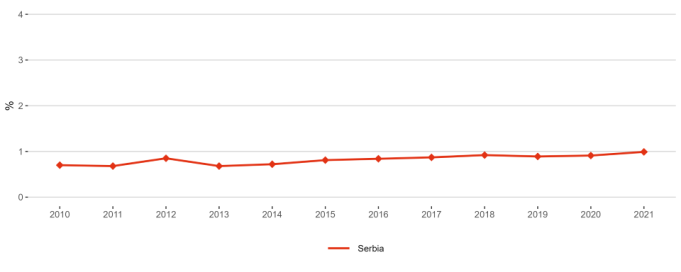
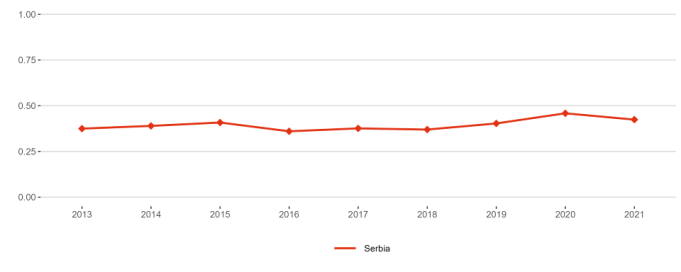
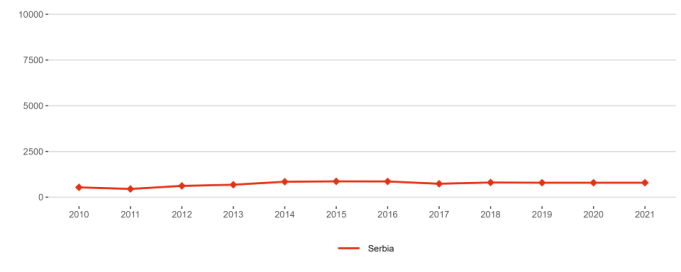
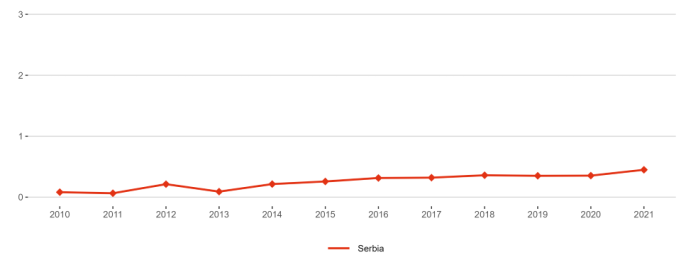
Priority 1: Deepening a truly functioning internal market for knowledge
Sub-priority 1.1: Open Science

Sub-priority 1.3: Gender equality, equal opportunities for all and inclusiveness
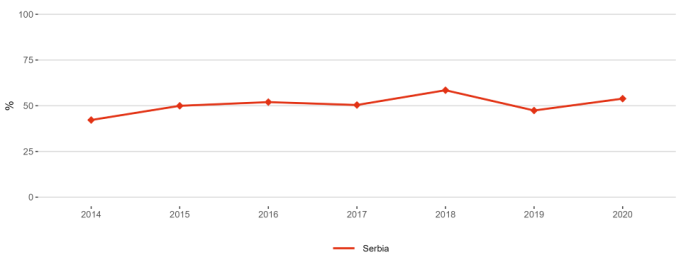

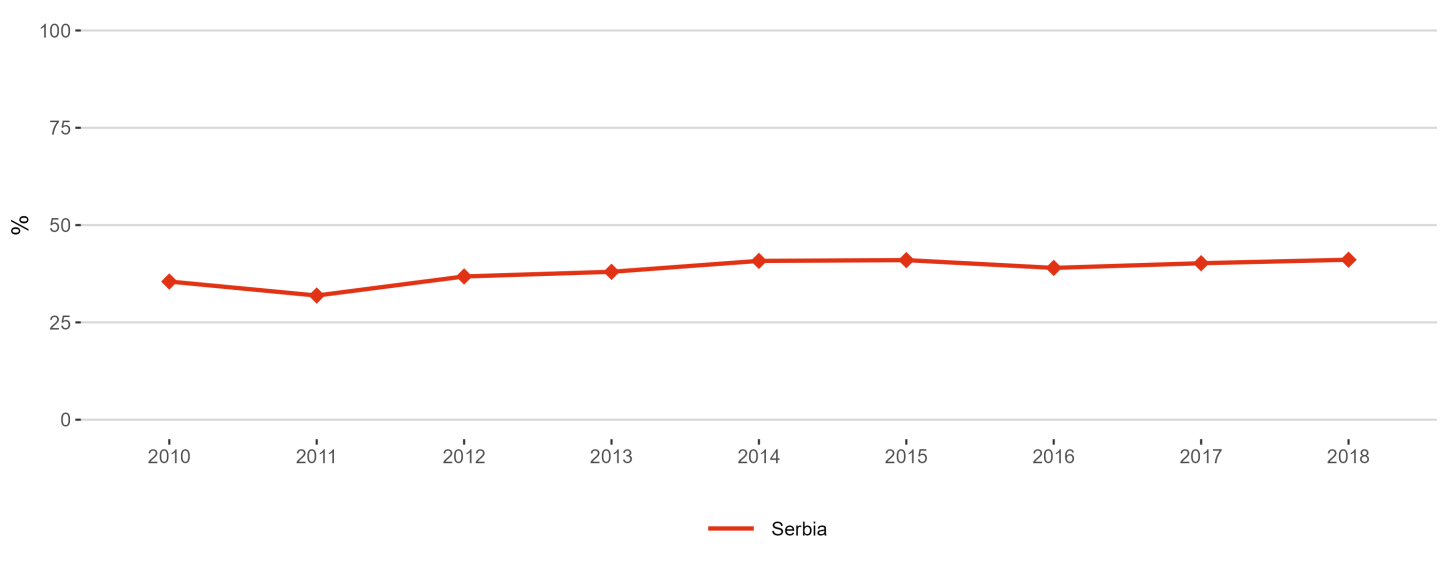
Sub-priority 1.4: Researchers’ careers and mobility and research assessment and reward systems



Sub-priority 1.5: Knowledge valorisation
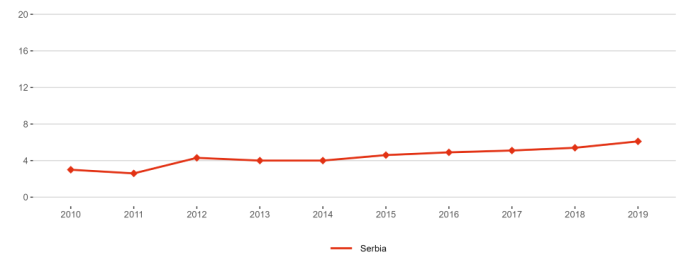
Sub-priority 1.6: Scientific leadership

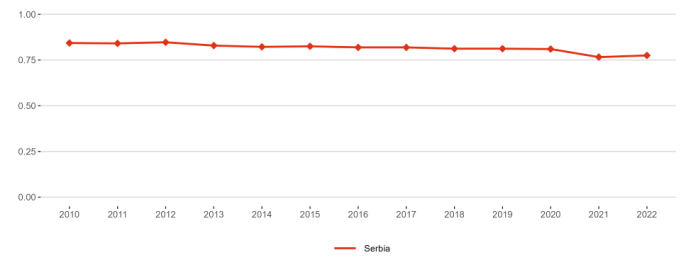
Sub-priority 1.7: Global engagement

Priority 2: Taking up together the challenges posed by the twin green and digital transition, and increasing society’s participation in the ERA
Sub-priority 2.1: Challenge-based ERA actions
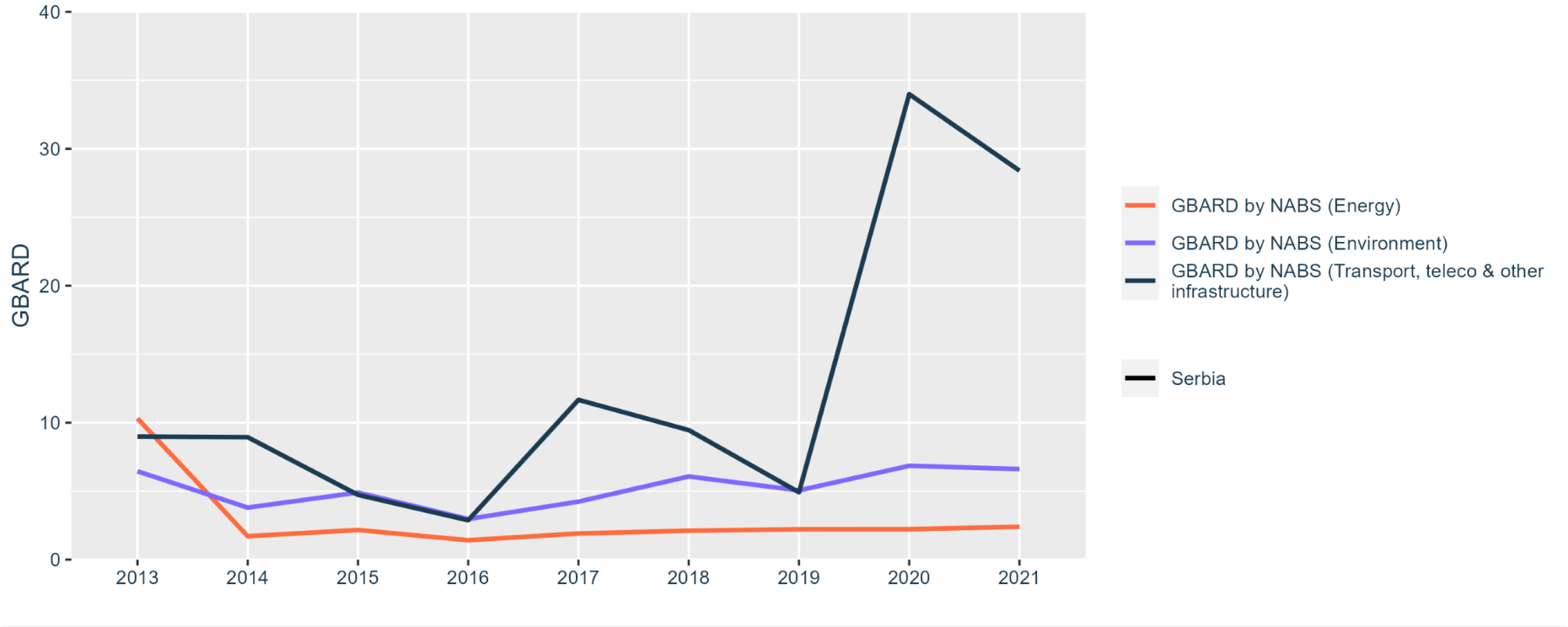
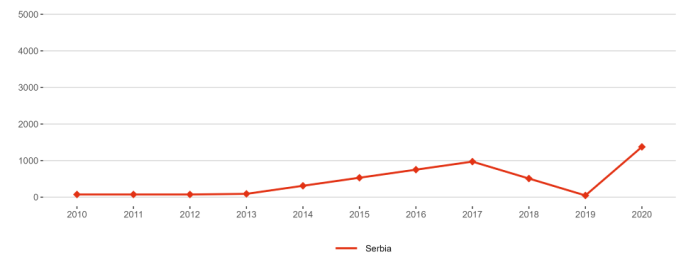

Sub-priority 2.3: Synergies with sectorial policies and industrial policy, in order to boost innovation ecosystems
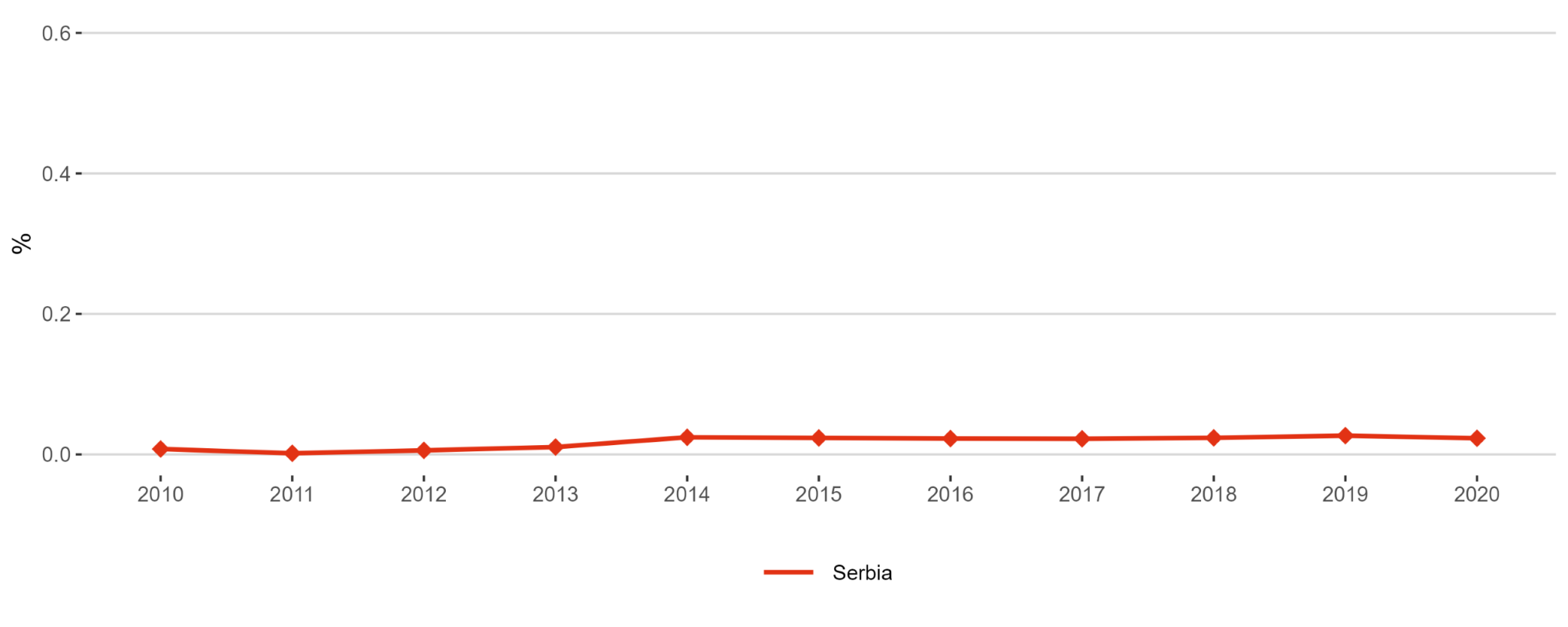
Sub-priority 2.4: An active citizen and societal engagement in R&I in all its dimensions

Priority 3: Amplifying access to research and innovation excellence across the Union
Sub-priority 3.1: More investments and reforms in countries and regions with lower R&I performance
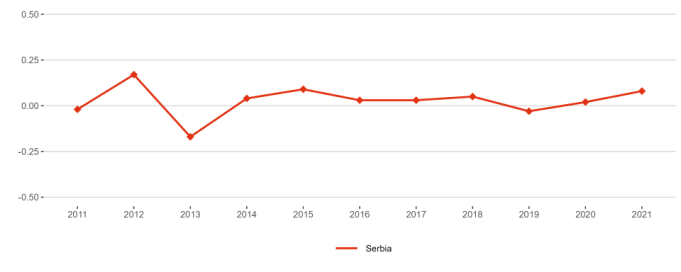
Priority 4: Advancing concerted research and innovation investments and reforms
Sub-priority 4.1: Coordination of R&I investments
